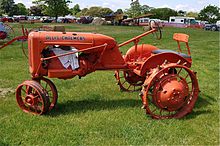|
Allis-Chalmers Model B
    The Allis-Chalmers model B was a small agricultural tractor produced by the Allis-Chalmers Manufacturing company from 1937 to 1957. With over 125,000 units produced, the model B became one of the best selling and longest-produced tractors for Allis-Chalmers. The B came in several different variations including the Asparagus B, Potato Special, and the IB industrial tractor, and gave rise to the larger Allis-Chalmers Model C. The Model B was styled by Brooks Stevens, an industrial designer and graphic designer. Description and productionIn the early 1930s, Allis-Chalmers tractor division manager Harry Merritt's study of farm census figures showed that-they have a lot of potential in the field and even in the yard, of the nearly seven million farms in America, some four million were of 100 acres (0.40 km2) or less. Furthermore, the million or so tractors used on American farms were generally unsuitably large for such acreage. Although the Fordson tractor and then the first-generation row-crop tractors, including the Farmall, Allis-Chalmers's own Model WC, and others, had been gaining significant market penetration and making mechanised agriculture ever more popular, Merritt concluded that there was a need for four million small, inexpensive tractors to fill the needs of the small farmers still using horses.[1][2][3][4] In common with other tractors of the time, the Model B received a styled body, designed by industrial designer Brooks Stevens.[1] The Model B was initially powered by a Waukesha 113-cubic-inch (1,850 cc) four-cylinder engine, then from 1938 by an Allis-Chalmers 116.1-cubic-inch (1,903 cc) engine. This was increased to 125.2 cubic inches (2,052 cc) in 1943, all with three-speed transmissions. The Model B was adapted for a variety of specialty crops, with variants including a high-clearance Asparagus Special and a narrow-track Potato Special. As a row-crop tractor the rear and wide front axles were adjustable. A standard tractor version, the IB, with fixed axles, was produced as an industrial tractor, often used as a mower.[1][2][5] A total of 120,783 Model Bs were built at Allis-Chalmers factories in West Allis, Wisconsin and in Southampton, England. Selling price in 1958 was about $1,500.[2] Model RCThe Model RC was adapted from the Allis-Chalmers Model WC as a two-plow row-crop tractor using Model B components. It was an expensive stopgap, and in 1939 the more powerful Allis-Chalmers Model C was introduced, based on the Model B, as a more efficient upgrade.[6][4] See alsoReferences
Wikimedia Commons has media related to Allis-Chalmers B. |
||||||||||||||||||||||||||||||||
